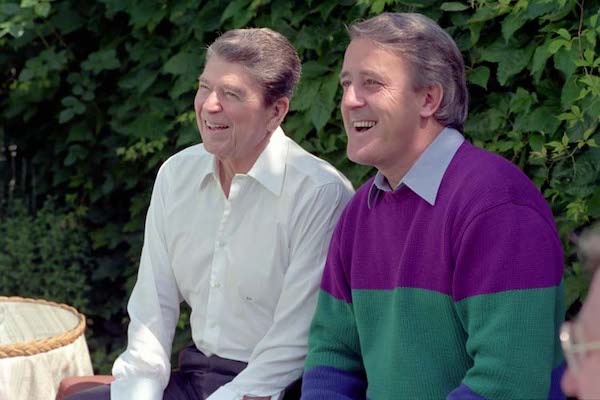The 1988 general election is remembered as a referendum on the proposed Canada-United States Free Trade Agreement (FTA). Before the election, Progressive Conservative Prime Minister Brian Mulroney had negotiated the deal with United States President Ronald Reagan and had already signed on the dotted line, but John Turner’s Liberals and Ed Broadbent’s New Democrats both opposed the FTA. Mulroney led a strong majority government, which would normally be enough to clear a Prime Minister’s path towards achieving his objectives, but the Liberal-heavy Senate would not approve the deal unless it received electoral support. So, off to the polls Canada went.
During the 1988 campaign, the result of the election was far from a foregone conclusion. Public opinion polls indicated that the country was divided on free trade. While Prime Minister Mulroney appealed to voters by emphasizing the opportunities for economic growth that the trade deal presented, Broadbent and Turner tapped into voters’ apprehensions about the loss of sovereignty and self-determination that could result from opening up the border. In the end, though most voters supported one of the parties that opposed the FTA, the Progressive Conservatives formed another majority government and free trade with the United States went ahead (the North American Free Trade Agreement, which created a trilateral arrangement inclusive of Mexico, took effect in 1994). Both the Senate and the first-past-the-post system bear some responsibility for this defining event in our history.
As we head into a federal election in 2019, just over thirty years since the “free trade election,” our trade relationship with the United States is, once again, poised to be a prominent issue on the campaign trail. Since the formation of a Liberal majority government in 2015, one of the most important, time-consuming, and high-profile portfolios for the federal government has been the negotiation of the “new NAFTA.”
To state the obvious, the political terrain has shifted considerably since the first deal was signed. The relationship between President Reagan and Prime Minister Mulroney was almost familial, whereas the dynamic between President Trump and Prime Minister Trudeau is far less warm. Also, President Reagan was keen to remove barriers in the trade relationship between the two countries. There was no significant public opposition to the FTA in the U.S., and the proposed agreement moved through both the House of Representatives and the United States Senate quickly and easily. President Trump, in contrast, has been heavily critical of the NAFTA agreement as unfair to America and has called it “perhaps the worst trade deal ever made.” During negotiations for the new NAFTA, he repeatedly threatened to walk away from the trade deal if America’s terms were not met. Prime Minister Trudeau made similar comments.
Back in 1988, the political interactions between the two countries seemed much easier to manage; the hard part was convincing Canadians to accept the potential risks of free trade with the United States. This time around, voters in both countries are mostly supportive of the new trade deal. However, many supporters of President Trump agree with his negative assessment of the historical trade relationship between Canada and the U.S. on the grounds that America has experienced a trade deficit and sustained job losses. Politically, President Trump had to create space between the old and new NAFTAs, so as to be able to bring his supporters onside with the new deal.
As the relationship between the two countries has changed, so has the global economy. America is no longer the stand-alone superpower it once was, and Canada has committed to diversifying its trade relationships. New trade agreements, including the Comprehensive Economic and Trade Agreement with the European Union (CETA) and the Comprehensive and Progressive Agreement for Trans-Pacific Partnership (CPTPP), fortify Canada’s relationships with trade partners beyond the U.S. Further, the new Trade Diversification Strategy seeks to, among other things, increase overseas exports by 50 per cent by 2025.
The fall 2019 election will provide an opportunity for Canadians to judge the federal government’s progress and performance on the trade file. Though it will not be a single-issue election, Canada’s international partnerships and its position in the global context will no doubt feature prominently in the debates ahead and will provide political parties the opportunity to differentiate themselves as they appeal to voters.
Image: Ronald Reagan Presidential Library, Reference no. C41189-7A

